Sustainable Public Procurement in the Building Construction Sector
Abstract
:1. Introduction
2. Regulatory and Literature Background
2.1. The Regulatory Framework
- Standard ISO 15686-5:2008, Buildings and Constructed Assets—Service-Life Planning—Part 5: Life Cycle Costing (revised July 2017—ISO 15686-5:2017) [24]. This standard represents the methodological foundation for life cycle cost analysis, presented in Section 3.1;
- Standard ISO 14040:2006, Environmental Management—Life Cycle Assessment—Principles and Framework [25]. This standard represents the methodological foundation for life cycle assessment analysis, mentioned in Section 3.2;
- Standard EN 15459-1:2007, Energy Performance of Buildings—Economic Evaluation Procedure for Energy Systems in Buildings (revised by EN 15459-1:2017, and repealed by UNI EN 15459-1:2018) [26]. This standard represents the methodological foundation for the global cost calculation, illustrated in Section 3.1;
- Standard EN ISO 15643-2:2011, Sustainability of Construction Works—Assessment of Buildings—Part 2: Framework for the Assessment of Environmental Performance [27]. This standard represents the methodological foundation for the assessment of a building’s environmental performance, as described in Section 3.2;
- Guidelines Accompanying Commission Delegated Regulation (EU) No 244/2012 [28]. This document is an integral part of the previous EU standard, specifically for the assessment of economic performances of buildings, deepened in Section 3.1. The guidelines establish a comparative methodology for calculating cost-optimal levels of minimum energy performance requirements for buildings and building elements.
- The second group includes the most relevant European directives oriented to the achievement of sustainability and energy efficiency in buildings. Furthermore, on these documents the methodology illustrated in Section 3 is founded:
- Directive 2002 [4]. This Directive is also known as the Energy Performance of Buildings Directive—EPBD. For European countries, it represents the reference framework for developing norms directed to achieve the energy efficiency of buildings;
- Directive 2010/31/EU of the European Parliament and of the Council of 19 May 2010 on the energy performance of buildings—recast [5]. This Directive is known as the Energy Performance of Buildings Directive recast—EPBD recast. It updates the above-mentioned one, and it introduces the Energy Performance Certificate—EPC as a mandatory certificate for all E.U. buildings. The EPCs represent a tool for introducing transparency in the calculation of the energy performance of buildings, and a tool for informing potential buyers/renters about the energy performance of buildings/dwellings [29];
- Directive 2018/844/EU—EPBD recast recast [6]. This Directive is oriented at supporting the cost-effective retrofit of existing buildings, with the aim to achieve a decarbonized building stock by 2050, and to mobilize investments;
- European Commission, A Renovation Wave for Europe—greening our buildings, creating jobs, improving lives. Communication from the European Commission to the European Parliament, the Council, the European Economic and Social Committee and the Committee of the Regions. Brussels, 14 October 2020 [30]. In 2020 the European Commission published this new strategy to boost renovation, aiming to pursue energy gains and economic growth. This strategy tries to double annual energy renovation rates within ten years, reduce emissions, enhance the quality of life of building occupants, and improve green jobs in the construction sector;
- European Commission, A European Green Deal. Striving to be the first climate-neutral continent, 2021 [31]. This represents a set of policies aiming at making Europe the first net-zero climate impact continent, in the framework of the Next Generation E.U. Recovery Plan and the E.U.’s seven-year budget. Specifically, Italy introduced the “Superbonus” (law n. 77, July 2020), to favor economic recovery after the COVID-19 crisis and the achievement of green objectives [32].
- Directive 2004/18/EC of the European Parliament and of the Council of 31 March 2004 on the coordination of procedures for the award of public works contracts, public supply contracts, and public service contracts [3];
- Directive 2014/23/EU of the European Parliament and of the Council of 26 February 2014 on the award of concession contracts [33];
- Directive 2014/24/EU of the European Parliament and of the Council of 26 February 2014 on public procurement and repealing Directive 2004/18/EC [2];
- Directive 2014/25/EU of the European Parliament and of the Council of 26 February 2014 on procurement by entities operating in the water, energy, transport, and postal services sectors and repealing Directive 2004/17/EC [34].
2.2. The Literature Background
3. Methodology
- Life cycle costing (or life cycle cost analysis);
- CO2 emissions calculation.
- 1.
- Life cycle cost analysis application
- 2.
- CO2 emissions calculation
- 3.
- Criteria weighting application
- 4.
- Sensitivity analysis application.
3.1. The Life Cycle Cost Analysis
3.1.1. LCC in Public Procurement Processes
3.2. The CO2 Emissions Calculation
3.3. The Criteria Weighting
3.4. The Sensitivity Analysis
4. Case Study
4.1. Assumptions: Input Data
5. Simulation and Results
5.1. LCC and CO2 Calculation Results
- the “general information input”, which includes the assumptions specified both by the procurer (Country in which the process is developed, in this case, Italy, and the related currency, Euro; lifespan in years; nominal discount rate, in this case, 3.50%; inflation rate, in this case, 2.50%) and by the supplier (list of the specific products offered, in this case, equal to two, the aluminum and the timber frames; the number of units offered for the selling/rental market, in this case, one by considering the entire external transparent envelop as a single unit; and lifespan in years, in this case, 20 for the aluminum frame and 15 for the timber frame);
- the “Life Cycle Costing—LCC information input”, which includes all the assumptions necessary for the LCC application, specifically: the discount rate, in this case, 3.5%; inflation rate, in this case, 2.50%; acquisition/operational/maintenance costs (with a breakdown of the specific items); other costs; and residual value/end-of-life costs;
- the “CO2 specific information input”, with assumptions related to the total embodied emissions, eventually detailed with a specification of the annual emissions during the usage stage (without enucleating the emissions due to electricity supply, having considered components with equal energy performances). For the calculation of the embedded emissions, the following operative steps are implemented by the tool:
- 1.
- the calculation of the embedded emissions per unit is obtained by summing all of the absolute amounts of embodied emission due to production, transport, installation, and disposal, calculated per unit;
- 2.
- the calculation of the embodied emissions over usage time is obtained by embedded emissions per unit * number of units to be purchased/leased (including necessary replacements, if planning horizon > lifespan) per offer;
- 3.
- the remaining share of embodied emissions (which are equally allocated over the lifetime of units) at the end of the planning horizon = total embedded emissions per offer—(number of units to be purchased/leased * embedded emissions per unit * (planning horizon [years]/lifespan [years])).
5.2. Criteria Weighting Results
5.3. Sensitivity Analysis Results
6. Discussion
- Firstly, the use of embodied carbon as a quantitative indicator for the calculation of CO2 emissions as done in this work should be transposed in monetary terms, as with the sustainability impact metrics (see: https://www.ecocostsvalue.com/eco-costs/, accessed on 29 June 2022), in order to complete the evaluation of the economic sustainability of the project options by internalizing the externalities into the global cost calculation;
- Secondly, the robustness of the method could be improved by introducing the results of a detailed life cycle assessment (LCA), produced contextually or before the LCC calculation: as mentioned, the LCA can be calculated by including not only the embodied carbon but also the embodied energy, due to the different stages in the product life cycle;
- Thirdly, strictly linked to the previous point, the methodology should be tested on a case suitable for the assessment of the energy consumptions assessment during the operative/use/management stage, whilst in this case, the energy analysis was not applicable to the two alternative products considered;
- Finally, the methodology is applied to a technological component, and it should be tested on a wider range of options covering different object scales (component/system/asset), different decision-making contexts, and different design levels.
7. Conclusions
Author Contributions
Funding
Acknowledgments
Conflicts of Interest
References
- European Commission, Directorate-General for Regional and Urban Policy. Stock-Taking of Administrative Capacity, Systems and Practices across the EU to Ensure the Compliance and Quality of Public Procurement Involving European Structural and Investment (ESI) Funds: Final Report; Publications Office: Luxembourg, 2016. [Google Scholar] [CrossRef]
- The European Parliament and the Council of the European Union. Directive 2014/24/EU of the European Parliament and of the Council of 26 February 2014 on Public Procurement and Repealing Directive 2004/18/EC; L 94/65; Official Journal of the European Union: Brussels, Belgium, 2014. [Google Scholar]
- Official Journal of the European Union. Directive 2004/18/EC of the European Parliament and of the Council of 31 March 2004 on the Coordination of Procedures for the Award of Public Works Contracts, Public Supply Contracts and Public Service Contracts; L 134/114; Official Journal of the European Union: Brussels, Belgium, 2004. [Google Scholar]
- European Parliament. Directive 2002/91/EC of the European Parliament and of the Council of 6 December 2002 on the Energy Performance of Buildings. Off. J. Eur. Union 2003, 1, 65–70. [Google Scholar]
- European Parliament. Directive 2010/31/EU of the European Parliament and of Council of 19 May 2010 on the Energy Performance of Buildings (Recast); Official Journal of the European Union: Brussels, Belgium, 2010. [Google Scholar]
- European Parliament. Directive (EU) 2018/844 of the European Parliament and of the Council. Off. J. Eur. Union 2018, 6, 75–91. [Google Scholar]
- European Commission. National Action Plans-GPP-Environment; European Parliament: Brussels, Belgium, 2022. [Google Scholar]
- Fregonara, E. Methodologies for supporting sustainability in energy and buildings. The contribution of Project Economic Evaluation. Energy Procedia 2017, 111, 2–11. [Google Scholar] [CrossRef]
- König, H.; Kohler, N.; Kreissig, J.; Lützkendorf, T. A Life Cycle Approach to Buildings. Principles, Calculations, Design Tools; Detail Green Books: Regensburg, Germany, 2010. [Google Scholar]
- Flanagan, R.; Norman, G. Life Cycle Costing for Construction; Royal Institution of Chartered Surveyors: London, UK, 1983. [Google Scholar]
- Department of Energy (DOE). Life Cycle Cost Handbook Guidance for Life Cycle Cost Estimate and Life Cycle Cost Analysis; Department of Energy (DOE): Washington, DC, USA, 2014. [Google Scholar]
- Rebitzer, G.; Hunkeler, D. Life cycle costing in LCM: Ambitions, opportunities, and limitations. Int. J. Life Cycle Assess. 2003, 8, 253–256. [Google Scholar] [CrossRef]
- Swarr, T.E.; Hunkeler, D.; Klöpffer, W.; Pesonen, H.L.; Ciroth, A.; Brent, A.C.; Pagan, R. Environmental life-cycle costing: A code of practice. Int. J. Life Cycle Assess. 2011, 16, 389–391. [Google Scholar] [CrossRef]
- Thiebat, F. Life Cycle Design; PoliTo Springer Series; Springer: Cham, Switzerland, 2019. [Google Scholar]
- Fregonara, E.; Giordano, R.; Ferrando, D.G.; Pattono, S. Economic-Environmental Indicators to Support Investment Decisions: A Focus on the Buildings’ End-of-Life Stage. Buildings 2017, 7, 65. [Google Scholar] [CrossRef]
- Fregonara, E.; Pattono, S. A sustainability indicator for building projects in presence of risk/uncertainty over time: A research experience. Aestimum 2018, 73, 173–205. [Google Scholar]
- Huntziger, D.N.; Eatmon, T.D. A life-cycle assessment of Portland cement manufacturing: Comparing the traditional process with alternative technologies. J. Clean. Prod. 2009, 17, 7. [Google Scholar]
- Nguyen, L.; Moseson, A.J.; Farnam, Y.; Spatari, S. Effects of composition and transportation logistics on environmental, energy and cost metrics for the production of alternative cementitious binders. J. Clean. Prod. 2018, 185, 628–645. [Google Scholar] [CrossRef]
- Tosti, L.; van Zomeren, A.; Pels, J.R.; Damgaard, A.; Comans, R.N.J. Life cycle assessment of the reuse of fly ash from biomass combustion as secondary cementitious material in cement products. J. Clean. Prod. 2020, 245, 118937. [Google Scholar] [CrossRef]
- Khushnood, R.A.; Rizwan, S.A.R.; Memon, S.A.; Tulliani, J.-M.; Ferro, G.A. Experimental Investigation on Use of Wheat Straw Ash and Bentonite in Self-Compacting Cementitious System. Adv. Mater. Sci. Eng. 2014, 2014, 832508. [Google Scholar] [CrossRef]
- Li, J.; Zhang, W.; Li, C.; Monteiro, P.J.M. Eco-friendly mortar with high-volume diatomite and fly ash: Performance and life-cycle assessment with regional variability. J. Clean. Prod. 2020, 261, 121224. [Google Scholar] [CrossRef]
- Caneda-Martínez, L.; Monasterio, M.; Moreno-Juez, J.; Martínez-Ramírez, S.; García, R.; Frías, M. Behaviour and properties of eco-cement pastes elaborated with recycled concrete powder from construction and demolition wastes. Materials 2021, 14, 1299. [Google Scholar] [CrossRef]
- Gupta, S.; Tulliani, J.-M.; Kua, H.W. Carbonaceous admixtures in cementitious building materials: Effect of particle size blending on rheology, packing, early age properties and processing energy demand. Sci. Total Environ. 2022, 807, 17. [Google Scholar] [CrossRef] [PubMed]
- ISO 15686:2008; Buildings and Constructed Assets—Service-Life Planning—Part 5: Life Cycle Costing; ISO/TC 59/CS 14. International Organization for Standardization: Geneva, Switzerland, 2008.
- ISO 14040:2006; Environmental Management—Life Cycle Assessment—Principles and Framework; ISO/TC 207. International Organization for Standardization: Geneva, Switzerland, 2006.
- Standard EN ISO 15459-1:2017; Energy Performance of Buildings—Economic Evaluation Procedure for Energy Systems in Buildings. European Committee for Standardization: Brussels, Belgium, 2017.
- Standard EN ISO 15643-2:2011; Sustainability of Construction Works—Assessment of Buildings—Part 2: Framework for the Assessment of Environmental Performance. European Committee for Standardization: Brussels, Belgium, 2011.
- European Parliament. Guidelines Accompanying Commission Delegated Regulation (EU) No 244/2012 of 16 January 2012 Supplementing Directive 2010/31/EU; European Parliament: Brussels, Belgium, 2012. [Google Scholar]
- Barreca, A.; Fregonara, E.; Rolando, D. EPC Labels and Building Features: Spatial Implications over Housing Prices. Sustainability 2021, 13, 5. [Google Scholar] [CrossRef]
- European Commission. A Renovation Wave for Europe—Greening our Buildings, Creating Jobs, Improving Lives; Communication from the European Commission to the European Parliament, the Council, the European Economic and Social Committee and the Committee of the Regions, Eds.; European Commission: Brussels, Belgium, 2020. [Google Scholar]
- European Commission. A European Green Deal. Striving to be the First Climate-Neutral Continent; European Commission: Brussels, Belgium, 2021. [Google Scholar]
- Fregonara, E.; Rubino, I. Buildings’ energy performance, green attributes and real estate prices: Methodological perspectives from the European literature. Aestimum 2021, 79, 43–73. [Google Scholar] [CrossRef]
- Official Journal of the European Union. Directive 2014/23/EU of the European Parliament and of the Council of 26 February 2014 on the Award of Concession Contracts; Official Journal of the European Union: Brussels, Belgium, 2014. [Google Scholar]
- Official Journal of the European Union. Directive 2014/25/EU of the European Parliament and of the Council of 26 February 2014 on Procurement by Entities Operating in the Water, Energy, Transport and Postal Services Sectors and Repealing Directive 2004/17/EC; Official Journal of the European Union: Brussels, Belgium, 2014. [Google Scholar]
- Rebaudengo, M.; Manzone, F.; Prizzon, F.; Caldera, C. Environmental quantity survey for buildings GPP requirements. In Proceedings of the 17th International Multidisciplinary Scientific GeoConference SGEM, Vienna, Austria, 27–29 November 2017. [Google Scholar]
- Curto, R.; Brigato, M.V.; Coscia, C.; Fregonara, E. Assessing strategies for developing sustainable tourism in the Iglesias area, Sardinia. Territorio 2014, 69, 123–133. [Google Scholar]
- Testa, F.; Annuziata, E.; Iraldo, F.; Frey, M. Drawbacks and opportunities of green public procurement: An effective tool for sustainable production. J. Clean. Prod. 2014, 112, 1893–1900. [Google Scholar] [CrossRef]
- Shen, L.; Zhang, Z.; Long, Z. Significant barriers to green procurement in real estate development. Resour. Conserv. Recycl. 2017, 116, 160–168. [Google Scholar] [CrossRef]
- Fuerst, F.; Oikarinen, E.; Harjunen, O. Green signalling effects in the market for energy-efficient residential buildings. Appl. Energy 2016, 180, 560–571. [Google Scholar] [CrossRef]
- Aydin, E.; Correa, S.B.; Brounen, D. Energy performance certification and time on the market. J. Environ. Econ. Manag. 2019, 98, 102270. [Google Scholar] [CrossRef]
- Kamal, A.; Al-Ghamdi, S.G.; Koc, M. Revaluing the costs and benefits of energy efficiency: A systematic review. Energy Res. Soc. Sci. 2019, 54, 68–84. [Google Scholar] [CrossRef]
- Taltavull de La Paz, P.; Perez-Sanchez, V.; Mora-Garcia, R.-T.; Perez-Sanchez, J.-C. Green Premium Evidence from Climatic Areas: A Case in Southern Europe, Alicante (Spain). Sustainability 2019, 11, 686. [Google Scholar] [CrossRef]
- Brounen, D.; Groh, A.M.; Haran, M. The value effects of green retrofits. J. Eur. Real Estate Res. 2020, 13, 301–319. [Google Scholar] [CrossRef]
- Marmolejo-Duarte, C.; García-Hooghuis, A.; Masià, A.G. How much and why are we willing to pay for energy-efficient homes? A stated preferences analysis in Barcelona. Archit. City Environ. 2020, 14, 9215. [Google Scholar] [CrossRef]
- Wilkinson, S.J.; Sayce, S. Decarbonising real estate: The evolving relationship between energy efficiency and housing in Europe. J. Eur. Real Estate Res. 2020, 13, 387–408. [Google Scholar] [CrossRef]
- Pommeranz, C.; Steininger, B.I. What Drives the Premium for Energy-Efficient Apartments—Green Awareness or Purchasing Power? J. Real Estate Financ. Econ. 2021, 62, 220–241. [Google Scholar] [CrossRef]
- De Giacomo, M.R.; Testa, F.; Iraldo, F.; Formentini, M. Does Green Public Procurement lead to Life Cycle Costing (LCC) adoption? J. Purch. Supply Manag. 2019, 25, 100500. [Google Scholar] [CrossRef]
- Life Cycle Costing (LCC) as a Contribution to Sustainable Construction. Guidance on the Use of the LCC Methodology and Its Application in Public Procurement. Davis Langdon Management Consulting, Final Guidance. 2007. Available online: https://www.google.it/url?sa=t&rct=j&q=&esrc=s&source=web&cd=&cad=rja&uact=8&ved=2ahUKEwi9y7b395X6AhWnLEQIHfpVBWwQFnoECAYQAQ&url=http%3A%2F%2Fwww.brita-in-pubs.eu%2Ftoolbox%2FLCC_files%2FLCC-methodology%2520Rev1%25205-3-07%2520(2).pdf&usg=AOvVaw2FhUDrHbPoouoOlAA1HEmU (accessed on 29 June 2022).
- Gustafsson, M.; Di Pasquale, C.; Pioppi, S.; Bellini, A.; Fedrizzi, R.; Bales, C.; Ochs, F.; Siè, M.; Holmberg, S. Economic and environmental analysis of energy renovation packages for European office buildings. Energy Build. 2017, 148, 155–165. [Google Scholar] [CrossRef]
- Rodrigues, C.; Freire, F. Building retrofit addressing occupancy: An integrated cost and environmental life-cycle analysis. Energy Build. 2017, 140, 388–398. [Google Scholar] [CrossRef]
- Rodrigues, C.; Freire, F. Adaptive reuse of buildings: Eco-efficiency assessment of retrofit strategies for alternative uses of an historic building. J. Clean. Prod. 2017, 157, 94–105. [Google Scholar] [CrossRef]
- Moschetti, R.; Brattebø, H. Combining Life Cycle Environmental and Economic Assessments in Building Energy Renovation Projects. Energies 2017, 10, 1851. [Google Scholar] [CrossRef]
- Silvestre, J.D.; Castelo, A.; Silva, J.; De Brito, J.L.; Pinheiro, M.D. Energy Retrofitting of a Buildings’ Envelope: Assessment of the Environmental, Economic and Energy (3E) Performance of a Cork-Based Thermal Insulating Rendering Mortar. Energies 2019, 13, 143. [Google Scholar] [CrossRef]
- Colli, C.; Bataille, A.; Antczak, E. Investigating eco-efficiency procedure to compare refurbishment scenarios with different insulating materials. Procedia CIRP 2020, 90, 322–327. [Google Scholar] [CrossRef]
- Galimshina, A.; Moustapha, M.; Hollberg, A.; Padey, P.; Lasvaux, S.; Sudret, B.; Habert, G. Statistical method to identify robust building renovation choices for environmental and economic performance. Build. Environ. 2020, 183, 107143. [Google Scholar] [CrossRef]
- Adell, A.; Seebach, D.; Moller, M. Smart SPP. Innovation through sustainable procurement. LCC-CO2 tool user guide. Visual guide to using the life cycle costing and CO2 assessment tool (LCC-CO2 tool). The Smart SPP Consortium. 2011. Available online: https://www.smart-spp.eu/fileadmin/template/projects/smart_spp/files/Guidance/Final_versions/EN_SMART_SPP_Tool_User_Guide_2011_FINAL.pdf (accessed on 29 June 2022).
- European Commission. Buying Green! A Handbook on Green Public Procurement; Publication Office of the European Union: Luxembourg, 2016. [Google Scholar]
- Fregonara, E.; Curto, R.; Grosso, M.; Mellano, P.; Rolando, D.; Tulliani, J.M. Environmental Technology, Materials Science, Architectural Design, and Real Estate Market Evaluation: A Multidisciplinary Approach for Energy-Efficient Buildings. J. Urban Technol. 2013, 20, 57–80. [Google Scholar] [CrossRef]
- Fregonara, E.; Giordano, R.; Rolando, D.; Tulliani, J.M. Integrating Environmental and Economic Sustainability in New Building Construction and Retrofits. J. Urban Technol. 2016, 23, 3–28. [Google Scholar] [CrossRef]
- Flanagan, R.; Kendell, A.; Norman, G.; Robinson, G.D. Life cycle costing and risk management. Constr. Manag. Econ. 1987, 5, 53–71. [Google Scholar] [CrossRef]
- Boussabaine, A.; Kirkham, R. Whole Life-Cycle Costing: Risk and Risk Responses; Blackwell Publising: Oxford, UK, 2004; pp. 56–83, 142–162. [Google Scholar]
- Oduyemi, O.; Okoroh, M.; Fajana, O.S. Risk assessment methods for life cycle costing in buildings. Sustain. Build. 2016, 1, 9–18. [Google Scholar] [CrossRef] [Green Version]
- Bourke, K.; Davies, H. Factors Affecting Service Life Predictions of Buildings: A Discussion Paper; Laboratory Report—Building Research Establishment; Garston: Watford, UK, 1997. [Google Scholar]
- Fregonara, E.; Ferrando, D.G. How to Model Uncertain Service Life and Durability of Components in Life Cycle Cost Analysis Applications? Stoch. Approach Factor Method Sustain. 2018, 10, 3642. [Google Scholar]


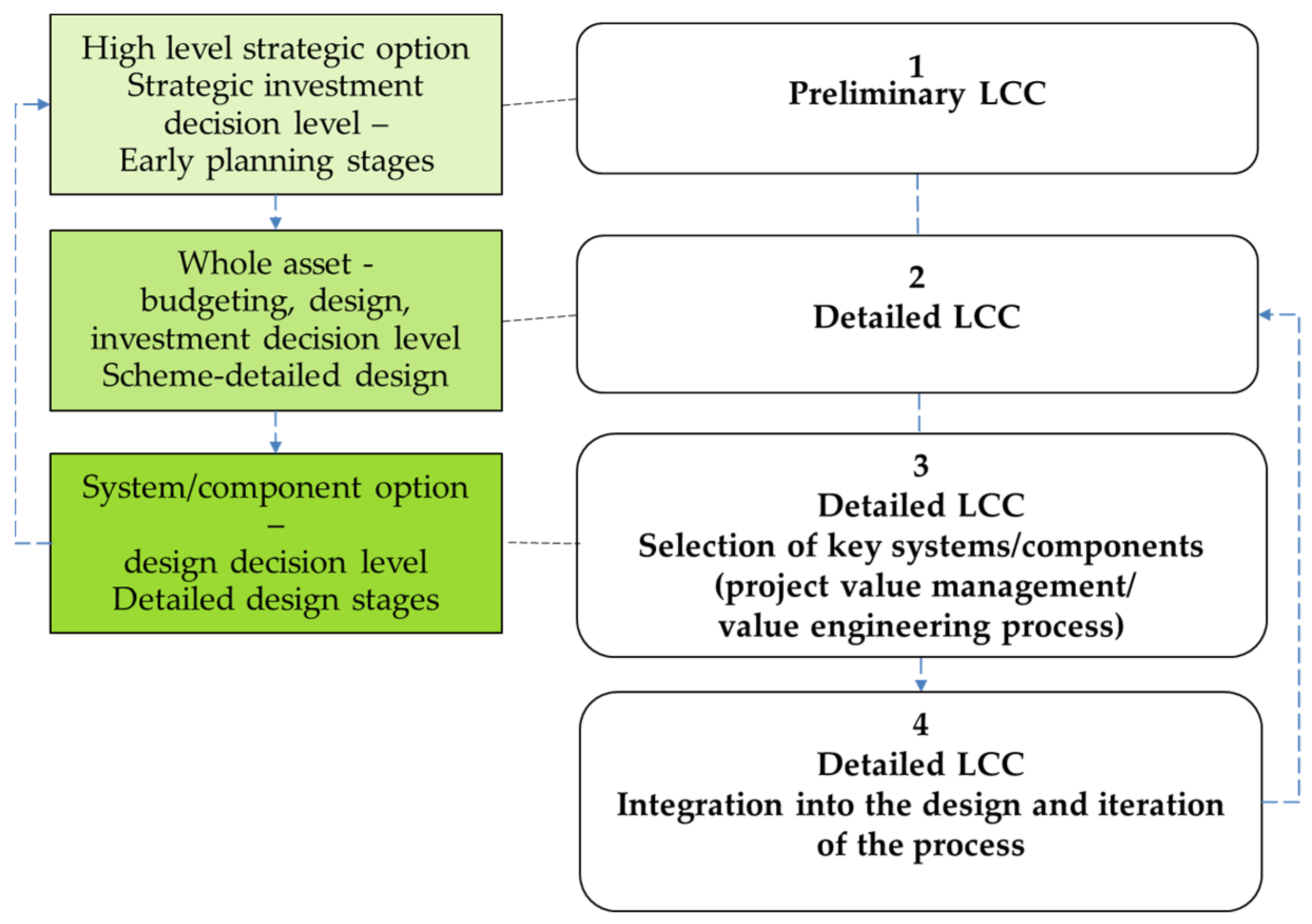

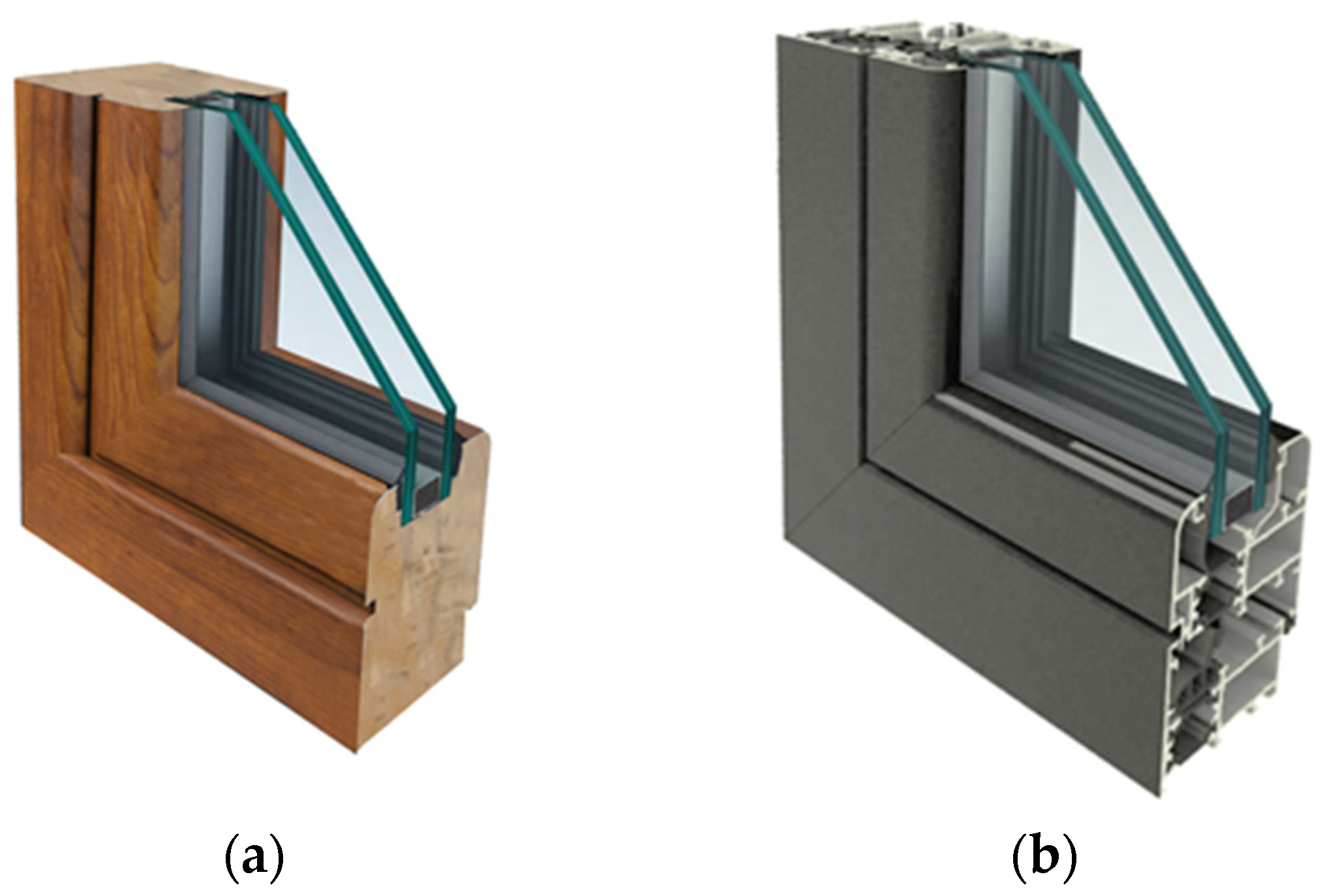
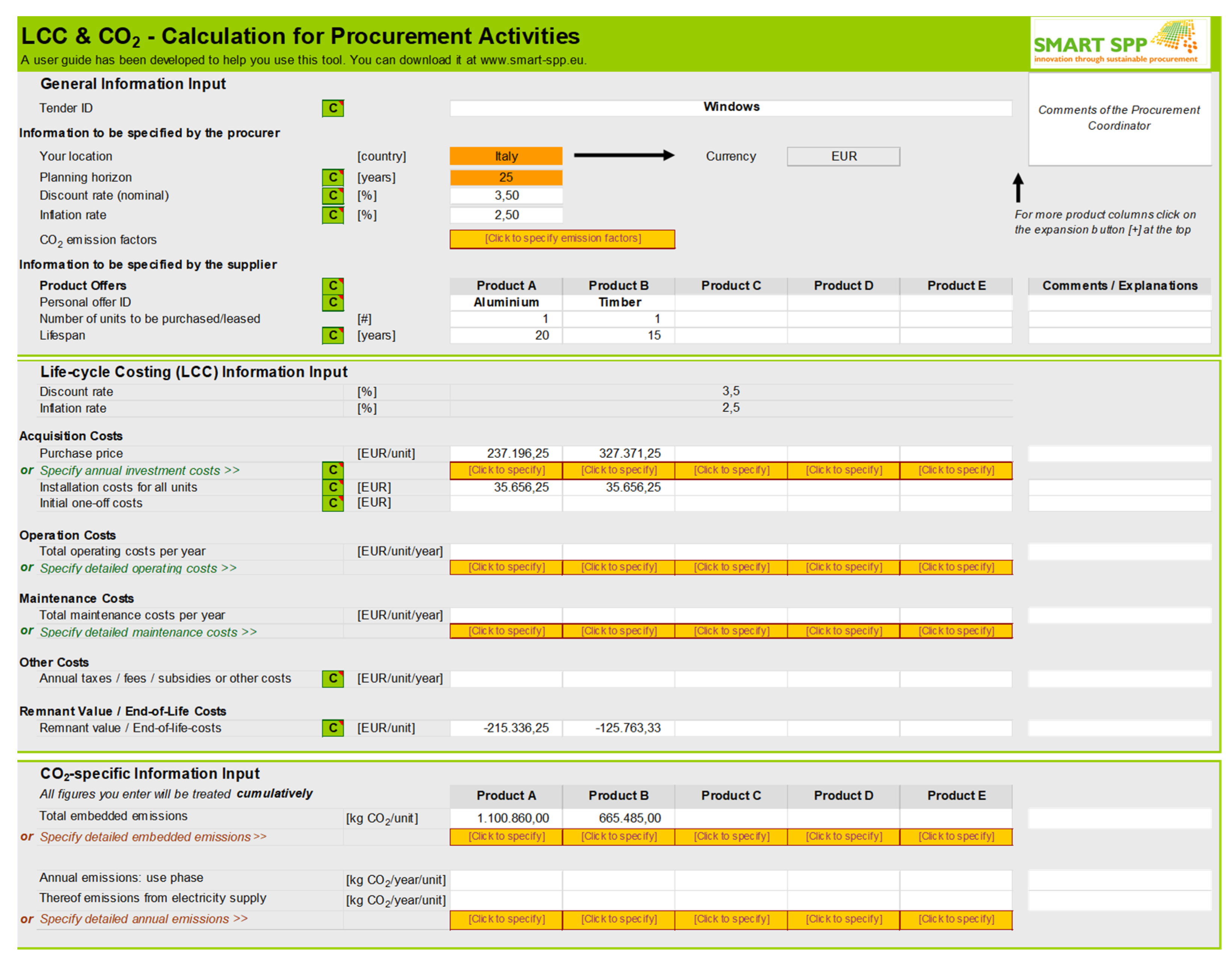


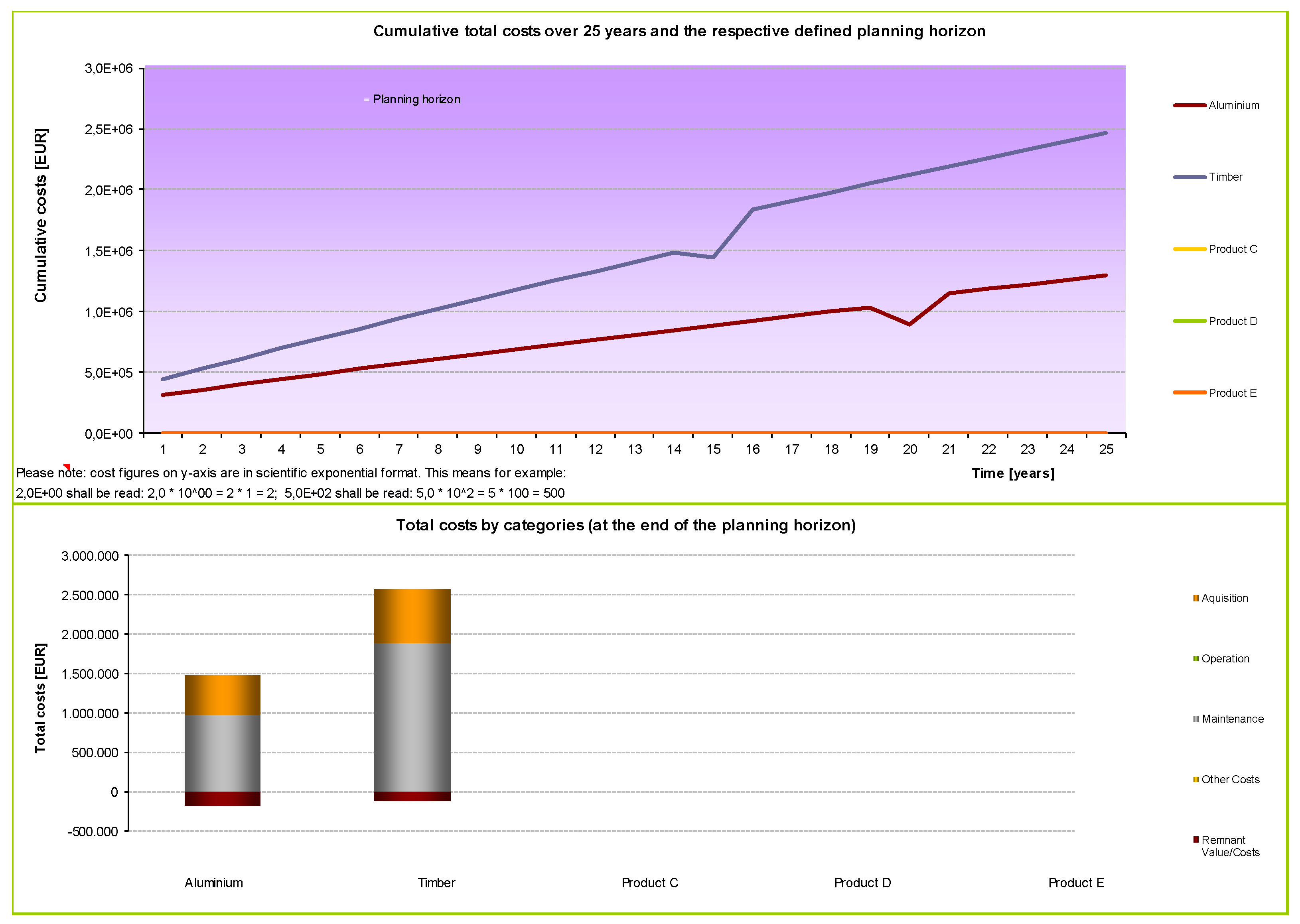
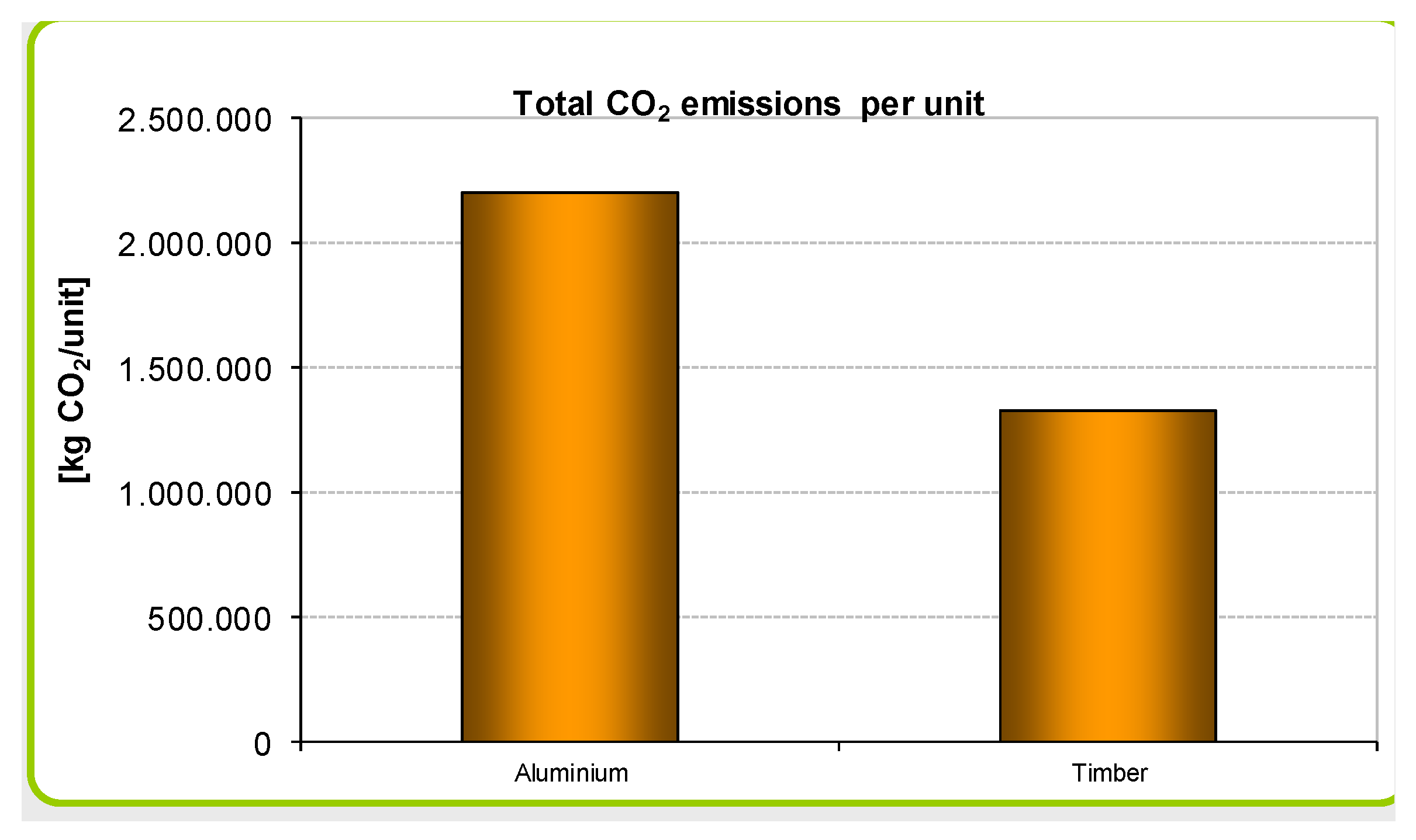




| Cost Drivers | Unit | Aluminum Frame | Unit | Timber Frame |
|---|---|---|---|---|
| Initial investment costs (incl. installation) | € | 272,852.50 | € | 363,027.50 |
| Annual running and replacement costs: | ||||
| - Inspection | € per year | 2371.96 | € per 6 months | 3273.71 |
| - Preemptive maintenance | € per year | 11,859.81 | € per year | 16,368.56 |
| - Maintenance work (light) | € every 5 years | 47,439.25 | € every 3 years | 65,474.25 |
| - Maintenance work (main) | € every 10 years | 83,018.69 | € every 7 years | 130,948.50 |
| - Replacement | € | 237,196.25 | € | 327,371.25 |
| Remnant value | € | 215,336.25 | € | 125,763.33 |
| CO2 (total embodied emissions) | Kg CO2 | 1,100,860.00 | Kg CO2 | 665,485.00 |
| Discount rate | % | 3.50 | % | 3.50 |
| Lifespan | years | 20 | years | 15 |
| Planning horizon | years | 25 | years | 25 |
| % Variation in Total Cost—Aluminum Frame | ||||||
|---|---|---|---|---|---|---|
| % Variation in Item Value | Inspection | Preemptive Maintenance | Maintenance Work (Light) | Maintenance Work (Main) | Replacement | Discount Rate |
| −60.00% | −2.97% | −14.83% | −10.16% | −4.90% | −9.93% | +25.27% |
| −40.00% | −1.98% | −9.88% | −6.77% | −3.27% | −6.62% | +15.78% |
| −20.00% | −0.99% | −4.94% | −3.39% | −1.63% | −3.31% | +7.40% |
| Base Scenario | 0.00% | 0.00% | 0.00% | 0.00% | 0.00% | 0.00% |
| +20.00% | +0.99% | +4.94% | +3.39% | +1.63% | +3.31% | −6.56% |
| +40.00% | +1.98% | +9.88% | +6.77% | +3.27% | +6.62% | −12.38% |
| +60.00% | +2.97% | +14.83% | +10.16% | +4.90% | +9.93% | −17.56% |
| % Variation in Total Cost—Timber Frame | ||||||
|---|---|---|---|---|---|---|
| % Variation in Item Value | Inspection | Preemptive Maintenance | Maintenance Work (Light) | Maintenance Work (Main) | Replacement | Discount Rate |
| −60.00% | −4.12% | −10.29% | −12.62% | −10.43% | −8.24% | +23.82% |
| −40.00% | −2.74% | −6.86% | −8.41% | −6.95% | −5.49% | +14.95% |
| −20.00% | −1.37% | −3.43% | −4.21% | −3.48% | −2.75% | +7.05% |
| Base Scenario | 0.00% | 0.00% | 0.00% | 0.00% | 0.00% | 0.00% |
| +20.00% | +1.37% | +3.43% | +4.21% | +3.48% | +2.75% | −6.30% |
| +40.00% | +2.74% | +6.86% | +8.41% | +6.95% | +5.49% | −11.95% |
| +60.00% | +4.12% | +10.29% | +12.62% | +10.43% | +8.24% | −17.03% |
Publisher’s Note: MDPI stays neutral with regard to jurisdictional claims in published maps and institutional affiliations. |
© 2022 by the authors. Licensee MDPI, Basel, Switzerland. This article is an open access article distributed under the terms and conditions of the Creative Commons Attribution (CC BY) license (https://creativecommons.org/licenses/by/4.0/).
Share and Cite
Fregonara, E.; Ferrando, D.G.; Tulliani, J.-M. Sustainable Public Procurement in the Building Construction Sector. Sustainability 2022, 14, 11616. https://doi.org/10.3390/su141811616
Fregonara E, Ferrando DG, Tulliani J-M. Sustainable Public Procurement in the Building Construction Sector. Sustainability. 2022; 14(18):11616. https://doi.org/10.3390/su141811616
Chicago/Turabian StyleFregonara, Elena, Diego Giuseppe Ferrando, and Jean-Marc Tulliani. 2022. "Sustainable Public Procurement in the Building Construction Sector" Sustainability 14, no. 18: 11616. https://doi.org/10.3390/su141811616
APA StyleFregonara, E., Ferrando, D. G., & Tulliani, J.-M. (2022). Sustainable Public Procurement in the Building Construction Sector. Sustainability, 14(18), 11616. https://doi.org/10.3390/su141811616







